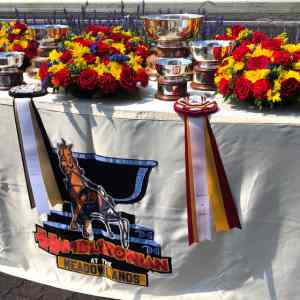Hambo kicks off Triple Crown quest
by Dean Hoffman
Late in his life when he’d retired after a legendary career in harness racing, Stanley Dancer sent me a memento of his career.
When you think of Dancer and his vast accomplishments, you certainly must wonder what he deemed his greatest achievement.
Was it winning the Little Brown Jug back to back in 1961-62 while he was still in his mid-30s?
Was it his first Hambletonian win with Nevele Pride in 1968? Or his last Hambletonian win behind Duenna because that last one came in his native state of New Jersey?
None of the above.
What Stanley Dancer selected as his proudest achievement was that he trained and drove three Triple Crown winners. Nevele Pride (1968) and Super Bowl (1972) won the Triple Crown for trotters while Most Happy Fella (1970) swept the big three races for pacers.
No other harness horseman trained and drove more than one Triple Crown winner. Dancer won three Triple Crowns in five seasons; he had every right to be proud.
That was a measure of how Stanley Dancer dominated the headlines in harness racing at the peak of his career. Having a horse healthy and sharp enough to beat the best of his generation in the Triple Crown events was the hallmark of a great horseman. And Stanley Dancer was every inch a great horseman.
His legacy is most evident this week as the harness racing world eagerly awaits Saturday’s Hambletonian, its greatest classic. Dancer drove four Hambletonian winners and trained a fifth one, a remarkable record that has never been matched. Dancer was also among the few drivers who drove in Hambletonian contested in three different states. Dancer’s first drive in the Hambletonian came in 1953 when the big event was contested at Good Time Park in Goshen, New York. He drove his first Hambletonian winner in 1968 at the DuQuoin State Fair in Illinois. His final Hambletonian winner came in 1983 with the filly Duenna in New Jersey.
Will harness racing salute a trotting Triple Crown winner this year? It’s entirely possible with the way that Father Patrick has dominated his foes over the past two seasons. He will bring a record of 16 wins in 17 career starts into Saturday’s Hambletonian and seems to be coming into the Hambletonian in peak form. The greatest threats he faces appear to be his stablemates Trixton and Nuncio.
Stanley Dancer learned in 1965 that “unbeatable” horses can get beat in the Hambletonian. That year he drove his colt Noble Victory, a winner of 26 races in 27 lifetime starts, and Noble Victory failed to win the three heats that he contested and went back to the barn after a series of stunning upsets.
To win the Triple Crown for trotters this season, Saturday’s Hambletonian winner, must sustain his form for almost three more months.
The second leg will be raced when the maple turns to gold in the Bluegrass as the best 3-year-olds gather for the Kentucky Futurity, second leg of the Triple Crown. It’s contested at The Red Mile in Lexington. The Futurity is harness racing’s most tradition test of champions, having been started in 1893.
If a horse wins the first two legs of the trotting Triple Crown, he must then demonstrate his versatility by taking the Yonkers Trot over the twice-around track in New York in late October. Many of the best sophomore trotters, including Father Patrick, have not yet raced on a half-mile oval, but the best horse can adapt to the turns. Father Patrick’s best times both as a 2-year-old and as a 3-year-old have come on the 5/8-mile track at Pocono so he should be capable.
The Triple Crown is not designed to be a walk in the park for even the best trotters. It is a true test of champions and that’s why it’s been won so sparingly.
Harness racing’s Triple Crowns for both trotters and pacers were started during the mid-1950s. They were designed as the harness counterparts of the Triple Crown for Thoroughbreds.
In 1955, Yonkers Raceway offered a jackpot purse in the first Yonkers Futurity (later renamed Yonkers Trot) for 3-year-old trotters. Its $73,840 purse in 1955 (that’s more than $656,000 in today’s dollars) caused a sensation in harness racing. The Yonkers Futurity was linked to the Hambletonian and Kentucky Futurity to form the Triple Crown for trotters.
That same year Yonkers inaugurated the William H. Cane Futurity (later renamed Cane Pace) in honor of the track’s founder. When Roosevelt Raceway started the Messenger Stakes a year later in 1956, the Cane and Messenger were linked with the traditional Little Brown Jug to form the Triple Crown for pacers.
The Triple Crowns were such inviting and lucrative targets that they proved irresistible. Scott Frost won the Triple Crown for trotters in 1955 and the 1960s saw a quartet of trotting Triple Crown winners (Speed Scot in 1963; Ayres in 1964, Nevele Pride in 1968, and Lindy’s Pride in 1969.)
In 1972 Stanley Dancer got his third Triple Crown winner when he drove Super Bowl to victory in the Kentucky Futurity despite Super Bowl’s sulky having flat tires in both heats.
There was then a void of trotting Triple Crown winners until Windsongs’s Legacy in 2004 and Glidemaster in 2006.
The pacing Triple Crown was first swept by Adios Butler in 1959 and he was followed by a trio of hobbled heroes in the turbulent 1960s: Bret Hanover in 1965, Romeo Hanover in 1966, and Rum Customer in 1968.
Most Happy Fella took the Triple Crown for Dancer in 1970.
He was followed by Niatross (1980), Ralph Hanover (1983), Western Dreamer (1997), Blissful Hall (1999) and No Pan Intended (2003).
Will harness racing welcome its newest Triple Crown winner in 2014? The quest all starts with Saturday’s Hambletonian.
Cover photo by Curtis Salonick


